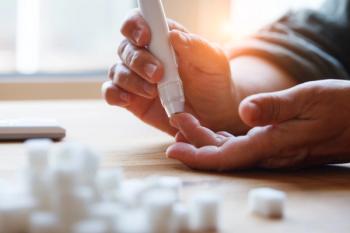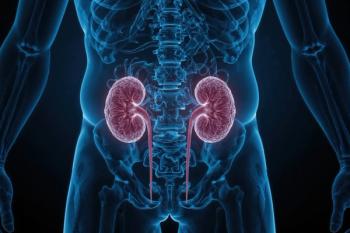
- Spectroscopy-12-01-2017
- Volume 32
- Issue 12
New Spectroscopy-Based Approaches in Bioanalysis and Personalized Medicine
Medical diagnostics is an exciting area of spectroscopy research, and one of the dreams is to develop spectroscopic tools that can be used for point-of-care diagnostics with a smartphone. Russ Algar, the 2017 Emerging Leader in Molecular Spectroscopy, is one of the scientists on that quest
Bioanalysis, and particularly medical diagnostics, is an exciting area of spectroscopy research. One of the dreams is to develop spectroscopic tools that can be used for point-of-care diagnostics with a smartphone. Russ Algar, an assistant professor in chemistry at the University of British Columbia (UBC), in Vancouver, Canada, is one of the scientists on that quest. Algar and his research group focus on the development of nontraditional fluorescent materials-such as quantum dots, luminescent lanthanide complexes, and semiconducting polymer dots-for biochemical sensing. They are studying how these materials can be applied to a variety of problems, including molecular medicine, personalized medicine, and yes, point-of-care diagnostics with smartphones. For his work, Algar has been chosen as the winner of second annual Emerging Leader in Molecular Spectroscopy award, presented by Spectroscopy magazine.
How did your interest in analytical chemistry and molecular spectroscopy begin?
I think the interest evolved naturally, with one part being inspiration from my undergraduate instructors in the subject and the other part being a good match to the way the gears turned in my head. Upon learning that I planned to major in chemistry in university, my senior calculus teacher in high school said that I was "too analytical" for chemistry and would end up in physics. She was half right, as I ended up doing a double major in chemistry and physics during my undergraduate studies, but she must not have been aware that analytical chemistry was an option.
Analytical chemistry and molecular spectroscopy are also diverse. They embrace technology, enable new fundamental discoveries about how nature works, strive to create practical inventions, and easily interface with other disciplines in chemistry, biology, physics, material science, and engineering. I really like having such a wide range of space in which to work and explore.
You have done some significant work developing smartphone-based point-of-care diagnostics in which photoluminescence from semiconductor quantum dot (QD) nanocrystals is measured by a smartphone camera. Can you briefly describe the assay used in this research and how smartphones are used in the process?
You don't have to go back too many years to find a desktop computer that would be outperformed by a modern smartphone, and the camera chip technology is largely shared between scientific equipment and consumer electronics. Thus, a smartphone has the potential to be used as an instrument for spectroscopy and scientific imaging.
Of course, the camera has been integrated into a smartphone in a way that is best for everyday photography, so what we, and many other groups, have been investigating is how to adapt and develop scientific imaging and spectroscopy around the smartphone. The motivation is that the smartphone is portable, inexpensive (at least compared to scientific and clinical instruments), and user friendly, supports data processing, storage, and communication, and is sufficiently ubiquitous that it is not a stretch to image using smartphone-based technology anywhere and anytime. Scientific and clinical measurements could potentially lose the shackles of the laboratory more than ever before.
Our initial research in this area has focused on finding and characterizing the best materials for fluorescence-based assays with smartphones. We have shown that QDs are great in this respect. They are much brighter than conventional fluorescent dyes, so their fluorescence is easier to detect and translates into a more sensitive assay. It's even possible to use blue light filtered from the camera flash to excite measurable fluorescence from a QD. Moreover, the emission of QDs can be precisely tuned to match the built-in color filters of a smartphone camera (red, green, blue [RGB]), which also helps improve sensitivity and facilitates the use of the different RGB color channels to detect different assay targets. In short, the properties of a QD can make fluorescence measurements on a smartphone not only possible, but also practical. From this point, it is possible, at least in principle, to take any existing fluorescence-based assay with QD and adapt it to a smartphone.
What was the inspiration for your work creating fluorescence assays that target protein biomarkers and cell types? Was this research inspired by a particular disease or condition? What were the biggest challenges? What benefits does this research bring to the field?
The inspiration is really the idea of molecular medicine, which focuses on understanding and assessing pathologies at the level of molecular mechanisms and cellular processes rather than the systemic observations of classical medicine. Rather than looking at blood pressure, temperature, coughing, and other symptoms of disease, the levels of certain proteins, genes, and cell types (usually recognized by proteins on their surface) are the useful medical information. Many people believe that molecular medicine is the key to earlier diagnosis of diseases and more effective interventions, resulting in better health outcomes. An important concept within this context is personalized medicine, where medical interventions are tailored to the specific manifestation of a disease in an individual rather than the population average, and are adjusted over time while monitoring the specific response of that individual to the intervention.
The foregoing ideas are all wonderful, but there is a measurement problem in making these ideas a viable reality. Many measurements need to be made at many different time points. The model of having a doctor order tests and a collected sample or patients themselves getting sent to a specialized laboratory, on-site or off-site, is not going to be sufficient. We need to have a model where nurses can do the tests at the hospital bedside, where doctors can do the tests at their private practices, and where patients can do some tests at home. Smartphone-based assays for protein and cell biomarkers can potentially enable this new model.
Another problem that is potentially addressed by smartphone-based assays is the discrepancy in health care between urban and rural or remote communities. A lot of resources that are taken for granted in cities are things for which people from rural and remote communities may need to travel far. A statistic that I've sometimes quoted to make this point is that half of the health care budget for one of Canada's northern territories is for patient travel. If molecular assays are available in the form of a smartphone assay, then they can be available in rural and remote communities without specialized labs, and both the patients and the health care budget will benefit. Similar arguments can be made for health care in less developed countries around the world.
I don't mean to suggest that a smartphone assay is a magic bullet. The full solutions to health care challenges will have many moving parts, but the concept embodied by the smartphone assay is likely to be an important component.
What steps led to your invention of QD-based concentric Förster resonance energy transfer (cFRET) probes with multifunctional detection capabilities?
It comes down to the idea of doing more with less, or doing more things more simply. QDs were tagged very early on as the best fluorescent material for multicolor measurements (and for good reason). The model that emerged was using n colors of QD to detect or label n different targets. It's the same multicolor model as with fluorescent dyes, but easier to implement and better in capability. So, the question that we asked was, can we use 1 color of QD to detect n different things? The answer is now yes, with n = 3.
We were very happy to hit n = 3 because most cellular processes occur as a cascade of multiple steps and often share molecular machinery with other processes. With n = 3, a good number of critical steps in those cascades can be detected with a single QD and using a cFRET probe is likely to be more effective than using three separate FRET probes, although we still need to prove this point.
How is your group's research and development (R&D) cFRET progressing? Has it been tested for the pathology and treatment of any specific diseases yet?
We are just now entering into the phase of R&D where we're moving cFRET from the test tube to a live biological system in the form of cultured cells. Our first big goal is to quantitatively track a multistep enzymatic cascade in single cells. It's exciting, because we're going to see if cFRET can enable the new insights and discoveries that we think it can. It will be an adventure because we know that a live cell is going to throw a whole bunch of new challenges at us, some foreseen and others unforeseen.
We're also looking at expanding the scope of cFRET as a concept, both in terms of the types of targets for detection and the materials utilized.
Your laboratory also focuses on studying novel materials and configurations for biosensing, such as luminescent lanthanide complexes (LLCs) and semiconducting polymer dots (Pdots) as materials for point-of-care diagnostics, cellular imaging, and biophotonic Boolean logic operators for simple and rapid "yes or no" screening assays for multiple pathogens or disease states. What specific developments are you hoping to achieve with spectroscopy in these areas? How is that research progressing?
Like QDs, the Pdots and LLCs have special properties in their luminescence versus the benchmark of fluorescent dyes.
For example, Pdots are exceptionally bright, even more so per particle than QDs, so we're looking at how these materials can be used as an alternative to QDs in our point-of-care (POC) diagnostic R&D. Our Pdot research is in the early stages, but looks promising, and I think we will have some good results by spring. We're still learning how to best work with these materials, which, despite some impressive work in the field at large, are less developed in terms of tailoring their overall chemistry. We're therefore also trying to develop new chemistries to help facilitate our envisioned applications for Pdots in POC diagnostics.
LLCs are special because of their very long excited-state lifetimes, which permit time-gated measurements. Time-gating is the idea of having a flash of excitation light, then a delay of microseconds to milliseconds prior to measuring the luminescence, which is great for suppressing scattering and fluorescence backgrounds from anything but the LLC. The concept is well-established but (in my opinion) underutilized, perhaps because LLCs have not typically been very bright. Some newer LLCs do much better in brightness, and we've been able to do some interesting spectroscopy with these materials. For example, elucidating a "sweet spot" for time-gated FRET, which balances two competing factors-higher FRET efficiency and the concomitant reduction in LLC donor lifetime. We've leveraged this idea to show some new twists on the design of high-contrast time-gated FRET probes, including photonic logic gates.
What we're hoping to achieve with the LLCs are some probes that can do "dirty work" in the sense that they can be added directly to a clinically relevant sample such as serum. In the case of photonic logic, the long-term idea is a probe or system of probes that can make an autonomous decision about the levels of multiple biomarkers and generate a binary "healthy/sick" output, where a "sick" output could be used as a decision point for further and more rigorous biomedical testing. The design of these probes may be complex, but their use and readout would be simple. Our research toward this concept is in its infancy. We're still very much learning how to design systems that can generate a single, clean binary output while detecting multiple biomarker targets, in the context of different types of biomarkers. The strategies that are useful with nucleic acid biomarkers are likely to be different than the strategies for protein biomarkers, which in turn will be different than the strategies for small-molecule biomarkers.
What research are you most proud of thus far?
I can't point to any one thing of which I'm most proud. Perhaps later in my career I will consider something to be a signature achievement, but for now I am proud of many things for different reasons. For example, the number of citations a paper has accrued, the prestige of the journal in which it was published, the effort and number of challenges we had to overcome to reach the point of publication, that a paper represents our first foray into a new area, or that we turned something unexpected into an interesting discovery-all these accomplishments give me a sense of satisfaction. I think it boils down to being proud of the cumulative scope and output of the research program and team that has been built over the last five years. That said, I spend most of my time looking forward to the next milestone and the next ambition. That's probably a good attitude early in one's career, although I sometimes need to be reminded to pause and celebrate accomplishments before moving on to the next challenge.
You have been a co-organizer for several symposia at Canadian Society for Chemistry conferences. Why do you think being active in the broader spectroscopy community is important? What have you learned or what other benefits have you received from being a co-organizer of such events?
On one hand, I think there is a certain obligation to pay it forward. I've participated in many symposia organized by others in my field; I should therefore reciprocate and organize symposia in which other people in my field can participate. A lot of unpaid work is done with respect to the professional activities of researchers, conference organization being only one example, so everyone needs to pitch in.
On the other hand, symposia organization is a great opportunity to network. It is becoming less and less viable to maintain an impactful research program in isolation. Conferences are a great venue to discover new ideas, learn from others, and find collaborations, and even more so when you're involved in the organization of symposia.
You maintain a group size of about 10 student and postdoctoral researchers. How do their theses and research projects impact your work? What kinds of collaboration is there between your students' work and your own?
The student theses and research projects are the best part of my job and the basis of my research program. My students, postdoctoral fellows, and I work together on the research; I do very little research without my trainees. Of course, the students and postdoctoral fellows do almost all the experimental work, but we collaborate on the development of ideas, designing, analyzing, and troubleshooting the experiments, and ultimately writing it up for publication. I think (and hope) that such a team approach provides a good training environment and maximizes productivity. Like many professors, I frequently miss being at the bench myself, but it is a worthwhile tradeoff for the broader scope of research possible with a team and the rewarding and fun experience of mentoring bright, curious, and ambitious students.
What other research are you currently working on that we have not already discussed?
Our research is quite multidisciplinary. In the first few years after I started my group, the main focus was analytical, in the sense of focusing on concepts for assay development. More recently, we had more focus on physical spectroscopy. Our next wave seems to be more focused on the biology and on materials science. The former was the natural progression of our early research from proof-of-concept to application, and the latter enables our next generation of new ideas for proof of concept. I think we can do some really cool things over the next five years but I don't want to get ahead of myself and forecast too much-research has a way of being unpredictable.
Your work has been widely published (about 75 journal articles and several book chapters with >3000 citations according to the ISI Web of Science) and you have given approximately 50 presentations at national and international conferences and institutions. How do you balance working on new or cutting-edge research and the demands of teaching, supervising students, as well as giving lectures and writing papers to share with your peers?
I'm not sure "balance" is the best word. "Manage" might be more accurate fit. The reality of the various demands of the job are that working from behind and working to deadlines are the norm. After five years, I am definitely still learning the best ways to manage these demands. A lot of perspiration from many people (myself, my students, postdoctoral fellows, and collaborators) has gone into the numbers that you noted. I am also blessed to have a spouse, Melissa, who has been supportive in so many different ways, including contributing to the research.
What do you plan to focus on next? Is there one big problem in spectroscopic analysis that you really want to tackle?
I think we're happy with the challenges and importance of the problems were trying to solve at the moment. We still have a lot of ideas to contribute and explore in these areas.
Do you have any advice for young scientists looking to follow a similar career path as yours?
First and foremost, the words of Thomas Edison, "Genius is 1% inspiration and 99% perspiration." I think I got further ahead by outworking people than by outsmarting them.
Second, learn to be confident in the face of criticism and being pushed to improve. It's not easy for any of us, but I think the path to success is learning from, embracing, and even asking for critical (and hopefully constructive) feedback rather than avoiding it.
Thirdly, for students in particular, try not to be overwhelmed by the accomplishments, knowledge, or experience of people at later stages of their education or career. You can't instantly become those people, but each day you can try to learn something new, improve in some way, or move something forward (even a little bit), and eventually end up at the same point. Never be complacent, but have confidence in the process.
For more on Algar, visit:
Articles in this issue
about 8 years ago
The Humble Instrument Logbook?about 8 years ago
Avantes, Inc.about 8 years ago
Amptek, Inc.about 8 years ago
Alluxa, Inc.about 8 years ago
ABB Measurement & Analyticsabout 8 years ago
EDAX, Inc.about 8 years ago
Edinburgh Instrumentsabout 8 years ago
Electro-Optics Technology, Inc.Newsletter
Get essential updates on the latest spectroscopy technologies, regulatory standards, and best practices—subscribe today to Spectroscopy.




